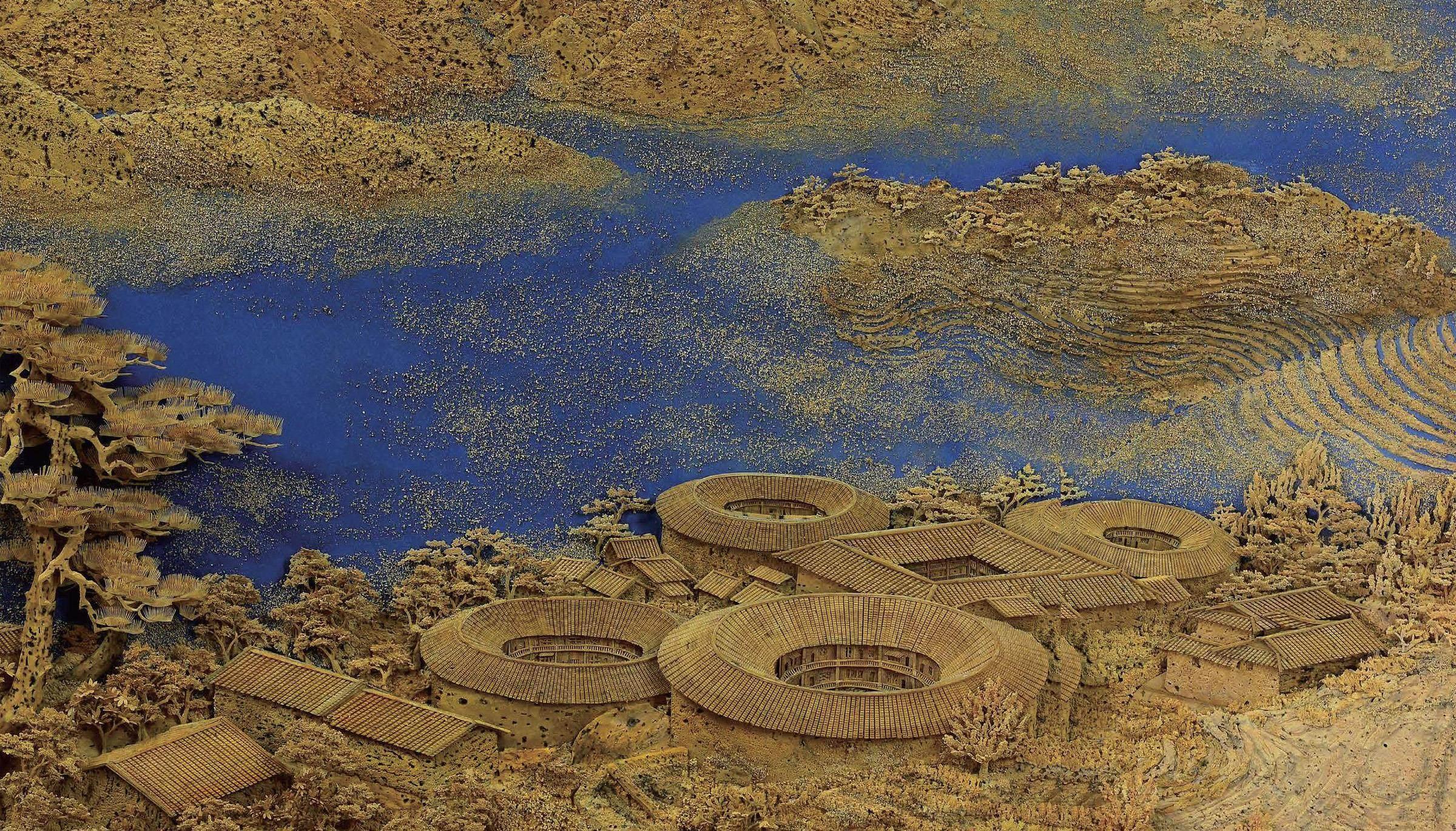Fuzhou Softwood Carving: Capturing the Grand in Miniature



Fujian Wisdom Series
The compiling group of Fujian Wisdom Series
Fujian Peoples Publishing House
January 2023
364.00 (CNY)
Over the past centuries, Fujian people have constantly pursued progress and put what they learned into practice, forming lofty ideals and values. Those intellectual, revolutionary, technical, and innovatory accomplishments are regarded as “Fujian Wisdom.” As part of the “Fujian Wisdom” series, this series vividly depicts Fujian, a place where great talents were born and raised. It tells moving stories of great minds who have made huge contributions. Through vivid depiction with stylish expressions, the wisdom of Fujian people from ancient to modern times is fully presented from new perspectives.
The delicate tip of a knife dances across the thin layers of softwood, maneuvering through twists, turns, and rotations. Like magic, these unassuming wood pieces, after being meticulously crafted, transform into exquisite pavilions, lifelike flora and fauna, and captivating landscapes. This is the astonishing art of Fuzhou Softwood Carving. Also known as Craft Wood Painting or Softwood Sculpture, it is one of the “Three Treasures of Fujian Craftsmanship” alongside Shoushan Stone Carving and Tuotai Lacquerware. Fuzhou Softwood Carving combines the techniques of carving and painting to create a unique art form that captures the essence of Chinese craftsmanship and painting traditions. Often referred to as “silent poetry” and “three-dimensional paintings,” it has even earned the title of “Oriental Art Treasure” abroad.
A New Craft Derived from Traditional Wood Carving
The art of Fuzhou Softwood Carving centers around creating pictorial scenes. Through the technique of “capturing the grand in miniature,” it condenses the beauty of nature into frames and screens, which can be as long as several meters or no larger than a sheet of A4 paper, achieving the artistic effect of encapsulating vast landscapes within limited space.
The subjects of softwood carvings mainly include traditional-style ancient architecture and landscape scenes featuring trees, plants, and rivers. There are also depictions of figures, animals, and birds. These elements, combining both movement and stillness in form and alternating between strength and softness in texture, create dynamic, harmonious, and vivid compositions that are reminiscent of traditional Chinese paintings. They exude a sense of natural charm and cultural richness.
In 1914, Xu Shiying, then the Fujian Provincial Governor, visited the Fujian Arts and Crafts Institute, one of Chinas earliest craft learning institutions established by the government, and presented a Christmas card made from thin softwood slices to the wood carving masters. He suggested they develop new products. Chen Chunrun, then the chief instructor of the wood carving subject at the Fujian Arts and Crafts Institute, along with students Wu Qiqi and Zheng Lixi, made great efforts to seek out suitable materials and eventually developed the art of softwood carving with Chinese painting aesthetics.
The newly developed softwood carving became known for its exceptional thinness and lightness, with intricate joining techniques making the craftsmanship exquisite. Together with novel designs, the exquisitely crafted softwood carvings quickly became popular handcrafted items both locally and nationally. Softwood carving workshops then began to emerge in Fuzhou, and the traditional practice of passing down craftsmanship through apprenticeships gained momentum.
Wu Qiqi is among the most influential figures in softwood carving. His Fuzhou Xiyuan Village Softwood Carving Workshop not only trained many family members in the art of softwood carving but also inspired craftsmen from Xiyuan Village and about ten surrounding villages to participate in softwood carving, contributing significantly to the maturity and refinement of the technique.
After the establishment of the Peoples Republic of China, Wu Qiqi and the artists in his family responded to the call for cooperative production and business operations, forming the Xiyuan Softwood Carving Production Group. This group later merged into a softwood carving production cooperative group, the Fuzhou Softwood Carving Production Cooperative, the Fuzhou Arts and Crafts Factory, and ultimately the Fuzhou Craft Wood Painting Factory in 1959.
During this period, the technique of softwood carving was greatly improved, and the production of plane card-like works and semi-dimensional hanging frameworks became more mature. Artisans also pioneered three-dimensional softwood carvings that showcased Beijings ancient architectural styles, which were represented by the word “Temple of Heaven,” and the innovation of hanging frame softwood carving work that imitated the Song Dynasty style elevated the artistic quality of softwood carvings.
In 1959, the softwood carving work “Fuzhou West Lake” was chosen as an indoor decoration for the Fujian Hall in the Great Hall of the People in Beijing, laying the foundation for the development of softwood carving from a folk craft to a high-level art form.
In June 2008, softwood carving was included in the second batch of national-level intangible cultural heritage representative projects. In May 2018, softwood carving was selected as one of the first batches of projects in the national revitalization plan for traditional crafts.
Softwood Carving Technique of Capturing the Grand in Miniature
The technique of softwood carving draws its origins from wood sculpture, but the tools used, material selection, production process, and artistic effects are distinct. The essence of the softwood carving technique lies in the pursuit of artistic craftsmanship, reflecting long-term aesthetic and cultural accumulations through incorporating traditional Chinese cultural elements such as sketching, perspective, ancient architecture, and landscaping. “Wielding the knife like wielding a brush, drawing beautiful scenes under the tip of the knife,” this analogy of carving tools being akin to painting brushes vividly captures one of the prominent features of the softwood carving technique.
The choice of softwood material for softwood carving is rigorous, predominantly using the phellem layer of Quercus variabilis Blume imported from countries like Portugal. This material is fine, soft, and elastic, with properties including impermeability, fire resistance, corrosion resistance, and abrasion resistance. Its surface features natural patterns and varied textures, making it suitable for shaping into thin slices for sculpting.
The intricate and complex process of creating softwood carvings involves dozens of steps, but it can be broadly divided into five stages:
The first stage is designing the form, determining whether the work will be a flat hanging frame, three-dimensional screen, or desktop ornament, and specifying the exact size of the work.
The second stage is sketching the design, meticulously depicting all the forms in the composition, including perspectives and textual inscriptions, and positioning the font and graphics of seals.
The third stage is crafting components, selecting suitable softwood, rice-paper plant, and other primary and auxiliary materials to create all the components of the work.
The fourth stage is assembling the setting, a crucial stage that demands strict adherence to the design, wherein the components are meticulously assembled according to the drafted design.
The fifth stage is framing and packaging, completing the work by adding the frame and outer packaging.
As a single softwood carving is often composed of dozens or even hundreds of tiny components, its creation is more meticulous than even embroidery. It requires careful collaboration among several individuals to complete.
Following the industrialization of softwood carving production, craftsmen began specializing in particular aspects, such as pavilions or trees. This specialization can lead to craftsmen excelling in their assigned areas but less skilled in creating components or performing other procedures. Consequently, while the entry threshold to softwood carving may not be high, mastery of the art remains challenging. Achieving a certain level of artistic accomplishment demands an understanding and grasp of traditional Chinese art as well as long-term dedication and accumulation of experience.

